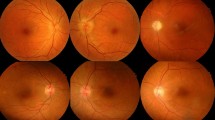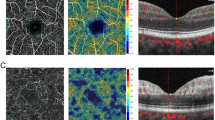Abstract
Aim
To investigate vascular density (VD) changes in the superficial (SCP) and deep capillary plexus (DCP), radial peripapillar capillary plexus (RPCP), Foveal avascular zone (FAZ) and thickness changes of peripapillary retinal nerve fiber layer (ppRNFL) and choroid (CT) using optical coherence tomography angiography (OCTA) ipsilateral eyes of patient with internal carotid artery stenosis (ICAS) and to compare the obtained values with kontralateral eyes of patients with İCAS and healthy individuals.
Methods
This prospective cross-sectional case–control study was conducted in 43 patients with a diagnosis of unilateral ICAS and 47 age- and sex-matched healthy subjects. The patients were divided into three groups. Group 1 consisted of ipsilateral eyes of patients with ICAS, group 2 consisted of contralateral eyes of patients with CAS and group 3 comprised healthy individuals without ICAS, All participants underwent a comprehensive ophthalmologic examination including OCTA.
Results
FAZ, Superficial parafoveal and superficial superior VD were significantly lower in group 1 compared to group 2 (p = < 0.001, p = 0.018 and 0.021, respectively). Group 1 also had lower superficial superior (p = 0.038), superficial inferior (p = 0.034), deep superior (p = 0.034), and deep inferior (p = 0.012) VD compared to group 3. There was no significant difference between the groups in terms of ppRNFLT, whereas CT and RPC mean, superior, and inside-disc VD values were significantly lower in group 1 compared to both group 2 and 3 (p < 0.05).
Conclusion
OCTA measurements may be useful in preventing irreversible ocular complications by detecting early structural changes in patients with ICAS before the development of symptomatic ocular ischemic syndrome.
Similar content being viewed by others
References
de Weerd M, Greving JP, de Jong AW et al (2009) Prevalence of asymptomatic carotid artery stenosis according to age and sex: systematic review and metaregression analysis. Stroke 40(4):1105–1113
Mizener JB, Podhajsky P, Hayreh SS (1997) Ocular ischemic syndrome. Ophthalmology 104(5):859–864
Brown GC, Magargal LE (1988) The ocular ischemic syndrome. Clinical, fluorescein angiographic and carotid angiographic features. Int Ophthalmol 11(4):239–251
Levin LA, Mootha VV (1997) Postprandial transient visual loss A symptom of critical carotid stenosis. Ophthalmology 104(3):397–401
Diener HC, Hankey GJ (2020) Primary and secondary prevention of ischemic stroke and cerebral hemorrhage: JACC focus seminar. J Am Coll Cardiol 75(15):1804–1818
Prasad K (2015) Pathophysiology and medical treatment of carotid artery stenosis. Int J Angiol 24(3):158–172
Biousse V (1997) Carotid disease and the eye. Curr Opin Ophthalmol 8(6):16–26
Terelak-Borys B, Skonieczna K, Grabska-Liberek I (2012) Ocular ischemic syndrome - a systematic review. Med Sci Monit 18(8):RA138–RA144
Sacco RL (1998) Identifying patient populations at high risk for stroke. Neurology 51(3 Suppl 3):S27–S30
Brown GC, Magargal LE (1988) The ocular ischemic syndrome. Int Ophthalmol 11:239–251. https://doi.org/10.1007/BF00131023
Petty GW, Brown RD Jr, Whisnant JP et al (1999) Ischemic stroke subtypes: a population-based study of incidence and risk factors. Stroke. https://doi.org/10.1161/01.str.30.12.2513
Jia Y, Bailey ST, Wilson DJ et al (2014) Quantitative optical coherence tomography angiography of choroidal neovascularization in age-related macular degeneration. Ophthalmology. https://doi.org/10.1016/j.ophtha.2014.01.034
Couturier A, Mané V, Bonnin S et al (2015) Capıllary plexus anomalies in diabetic retinopathy on optical coherence tomography angiography. Retina 35(11):2384–2391
Coscas F, Glacet-Bernard A, Miere A et al (2016) Optical coherence tomography angiography in retinal vein occlusion: evaluation of superficial and deep capillary plexa. Am J Ophthalmol. https://doi.org/10.1016/j.ajo.2015.10.008
Nakaizumi A, Puro DG (2011) Vulnerability of the retinal microvasculature to hypoxia: role of polyamine-regulated KATP channels. Invest Ophthalmol Vis Sci. https://doi.org/10.1167/iovs.11-8176
Costa VP, Kuzniec S, Molnar LJ et al (1997) Clinical findings and hemodynamic changes associated with severe occlusive carotid artery disease. Ophthalmology. https://doi.org/10.1016/s0161-6420(97)30066-9
Heßler H, Zimmermann H, Oberwahrenbrock T et al (2015) No Evidence for retinal damage evolving from reduced retinal blood flow in carotid artery disease. Biomed Res Int. https://doi.org/10.1155/2015/604028
Brown GC, Brown MM, Magargal LE (1986) The ocular ischemic syndrome and neovascularization. Trans Pa Acad Ophthalmol Otolaryngol 38(1):302–306
Ikram MK, Cheung CY, Lorenzi M et al (2013) Workshop on retinal biomarker for diabetes group retinal vascular caliber as a biomarker for diabetes microvascular complications. Diabet Care 36(3):750–759
Seidelmann SB, Claggett B, Bravo PE et al (2016) Retinal vessel calibers in predicting long-term cardiovascular outcomes: the atherosclerosis risk in communities study. Circulation 134(18):1328–1338. https://doi.org/10.1161/CIRCULATIONAHA.116.023425
Frost S, Kanagasingam Y, Sohrabi H et al (2013) Retinal vascular biomarkers for early detection and monitoring of Alzheimer’s disease. Transl Psychiatry. https://doi.org/10.1038/tp.2012.150
De Silva DA, Manzano JJ, Liu EY et al (2011) Multi-centre retinal stroke study group retinal microvascular changes and subsequent vascular events after ischemic stroke. Neurology. https://doi.org/10.1212/WNL.0b013e31822c623b
MRC European Carotid Surgery Trial (1991) interim results for symptomatic patients with severe (70–99%) or with mild (0–29%) carotid stenosis. European Carotid Surgery Trialists' Collaborative Group. Lancet. 337(8752):1235–1243. PMID: 1674060.
North American Symptomatic Carotid Endarterectomy Trial Collaborators, Barnett HJM, Taylor DW, Haynes RB. et al. (1991) Beneficial effect of carotid endarterectomy in symptomatic patients with high-grade carotid stenosis. N Engl J Med, 325(7):445–453. https:// doi: https://doi.org/10.1056/NEJM199108153250701.
North American Symptomatic Carotid Endarterectomy Trial (1991) Methods, patient characteristics, and progress. Stroke, 22(6):711–720
Lahme L, Marchiori E, Panuccio G et al (2018) Changes in retinal flow density measured by optical coherence tomography angiography in patients with carotid artery stenosis after carotid endarterectomy. Sci Rep. https://doi.org/10.1038/s41598-018-35556-4
Mendrinos E, Machinis TG, Pournaras CJ (2010) Ocular ischemic syndrome. Surv Ophthalmol 55(1):2–34
Hayreh SS (2005) Prevalent misconceptions about acute retinal vascular occlusive disorders. Prog Retin Eye Res 24(4):493–519
de Carlo TE, Romano A, Waheed NK et al (2005) review of optical coherence tomography angiography (OCTA). Int J Retina Vitreous. https://doi.org/10.1186/s40942-015-0005-8
Kashani AH, Chen CL, Gahm JK et al (2017) Optical coherence tomography angiography: a comprehensive review of current methods and clinical applications. Prog Retin Eye Res. https://doi.org/10.1016/j.preteyeres.2017.07.002
Al-Sheikh M, Tepelus TC, Nazikyan T et al (2017) Repeatability of automated vessel density measurements using optical coherence tomography angiography. Br J Ophthalmol. https://doi.org/10.1136/bjophthalmol-2016-308764
Zhang J, Tang FY, Cheung CY, Chen H (2020) Different effect of media opacity on vessel density measured by different optical coherence tomography angiography algorithms. Transl Vis Sci Technol 9(8):19. https://doi.org/10.1167/tvst.9.8.19
Zhang J, Tang FY, Cheung C, Chen X, Chen H (2021) Different effect of media opacity on automated and manual measurement of foveal avascular zone of optical coherence tomography angiographies. Br J Ophthalmol. https://doi.org/10.1136/bjophthalmol-2019-315780
Lee CW, Cheng HC, Chang FC et al (2019) Optical coherence tomography angiography evaluation of retinal microvasculature before and after carotid angioplasty and stenting. Sci Rep. https://doi.org/10.1038/s41598-019-51382-8
Pierro L, Arrigo A, De Crescenzo M et al (2021) Quantitative optical coherence tomography angiography detects retinal perfusion changes in carotid artery stenosis. Front Neurosci 22(15):640666. https://doi.org/10.3389/fnins.2021.640666
Sayin N, Kara N, Uzun F, Akturk IF (2015) A quantitative evaluation of the posterior segment of the eye using spectral-domain optical coherence tomography in carotid artery stenosis: a pilot study. Ophthalmic Surg Lasers Imaging Retina. https://doi.org/10.3928/23258160-20150213-20
Dagdelen K, Muz OE (2021) Investigation of macular and optic nerve head structural changes using spectral domain optical coherence tomography in internal carotid artery stenosis. Int Ophthalmol 41(3):875–882
Wang H, Wang YL, Li HY (2017) Sub foveal choroidal thickness and volume in severe internal carotid artery stenosis patients. Int J Ophthalmol. https://doi.org/10.18240/ijo.2017.12.13
Wang D, Li Y, Zhou Y et al (2017) Asymptomatic carotid artery stenosis and retinal nerve fiber layer thickness. A community-based, observational study. PLoS One. https://doi.org/10.1371/journal.pone.0177277
Kim DY, Joe SG, Lee JY et al (2015) Choroidal thickness in eyes with unilateral ocular ischemic syndrome. J Ophthalmol. https://doi.org/10.1155/2015/620372
Kang HM, Lee CS, Lee SC (2014) Thinner subfoveal choroidal thickness in eyes with ocular ischemic syndrome than in unaffected contralateral eyes. Graefes Arch Clin Exp Ophthalmol. https://doi.org/10.1007/s00417-014-2609-3
Kang HM, Choi JH, Koh HJ et al (2019) Significant changes of the choroid in patients with ocular ischemic syndrome and symptomatic carotid artery stenosis. PLoS One. https://doi.org/10.1371/journal.pone.0224210
Li S, Lang X, Wang W et al (2019) Choroidal vascular changes in internal carotid artery stenosis: a retrospective cohort study in Chinese population. BMC Ophthalmol. https://doi.org/10.1186/s12886-019-1218-7
Nickla DL, Wallman J (2010) The multifunctional choroid. Prog Retin Eye Res. https://doi.org/10.1016/j.preteyeres.2009.12.002
Costa VP, Kuzniec S, Molnar LJ et al (1998) Collateral blood supply through the ophthalmic artery: a steal phenomenon analyzed by color Doppler imaging. Ophthalmology. https://doi.org/10.1016/S0161-6420(98)94025-8
Hayreh SS, Piegors DJ, Heistad DD (1997) Serotonin-induced constriction of ocular arteries in atherosclerotic monkeys Implications for ischemic disorders of the retina and optic nerve head. Arch Ophthalmol. https://doi.org/10.1001/archopht.1997.01100150222012
Funding
The authors did not receive support from any organization for the submitted work.
Author information
Authors and Affiliations
Corresponding author
Ethics declarations
Conflict of interest
All authors certify that they have no affiliations with or involvement in any organization or entity with any financial interest or non-financial interest in the subject matter or materials discussed in this manuscript.
Informed consent
This work was done at University of Health Sciences Adana City Training and Research Hospital. The authors declare that they have no known competing financial interests or personal relationships that could have appeared to influence the work reported in this article. The authors (all) meet all four criteria of the ICMJE.
Additional information
Publisher's Note
Springer Nature remains neutral with regard to jurisdictional claims in published maps and institutional affiliations.
Rights and permissions
About this article
Cite this article
İncekalan, T.K., Taktakoğlu, D., Şimdivar, G.H.N. et al. Optical cohorence tomography angiography findings in carotid artery stenosis. Int Ophthalmol 42, 2501–2509 (2022). https://doi.org/10.1007/s10792-022-02297-3
Received:
Accepted:
Published:
Issue Date:
DOI: https://doi.org/10.1007/s10792-022-02297-3




